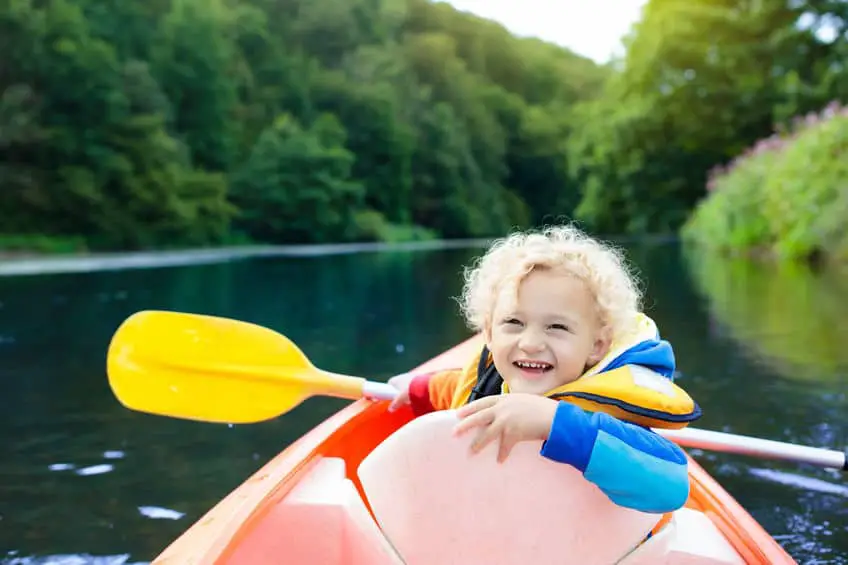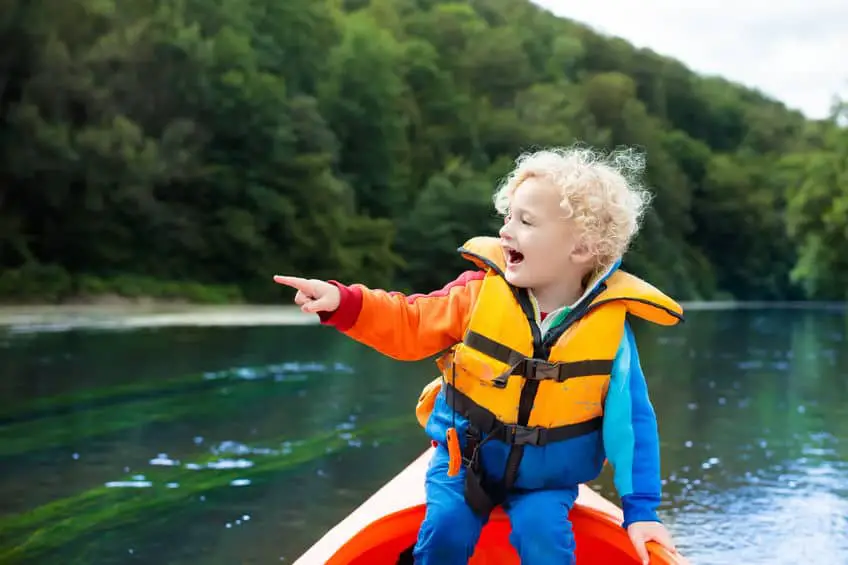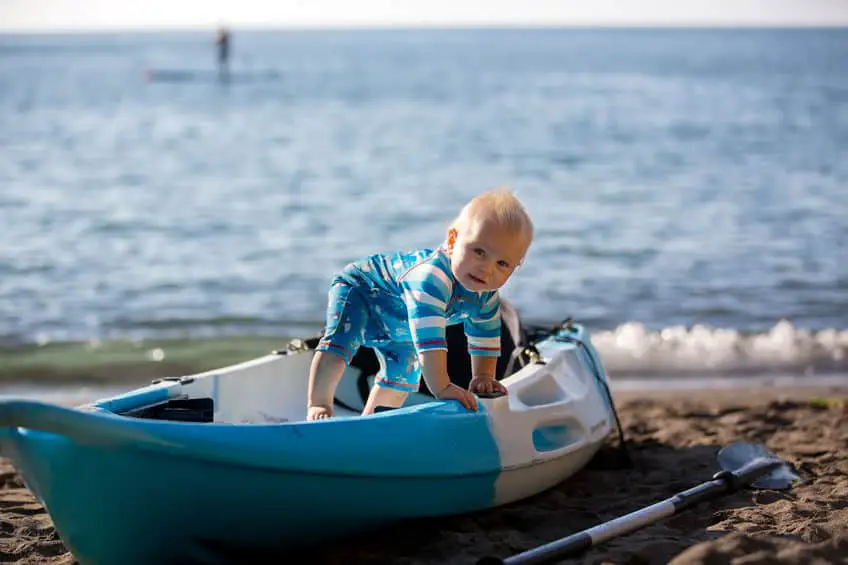
Spending time outdoors can help us recover from mental fatigue and is a good way to stay active. Kayaking is a fun and healthy activity that lets you burn extra energy while connecting with nature. You can even enjoy this water sport with your whole family.
Can you kayak with a baby? There isn’t an age limit attached to kayaking; however, it is not recommended to take a newborn/infant baby (0-12 months) on a kayak.
When kayaking with children, the focus isn’t on how old the child is but more about what the child’s ability and maturity level is. Safety is the most important factor to consider, and there are several precautions to take before getting out on the water.
Guidelines
According to the U.S. Coast Guard, ages 2-5 are good ages to let children start kayaking, but should share a kayak with a parent or adult. The general rules for bringing a toddler out in a kayak are:
- They must be able to sit still
- They should be able to float by themselves on the water
- They should weigh at least 18 pounds
- Need to wear a snug-fitted personal floatation device
The time before infants can fit into a proper personal floatation device, they should not be out on a boat.
Where To Kayak With Children
When kayaking with children, you should take them out on calm waters. Always avoid paddling against any strong currants when you are first starting out. When you and your child become more experienced, you can safely test out other environments.
It is a good idea to study the current and kayak traffic of the location you are planning to check out. Become experienced with all the dangers you might encounter, some are as apparent as others.
If you’re interested in reading more about the unexpected dangers of kayaking, you can read “Kayak Fishing is More Dangerous Than You Think, Here’s Why”. Recreational kayakers and kayak anglers share a lot of water, so the article is relevant to anyone looking to just float along on some calm water.
Age Appropriate Riding
Children under the age of 8 years old should share a tandem kayak with a parent or adult. It is a good idea for the child to sit in the front of the kayak so that you can easily monitor them while paddling. Children 8 and older can start paddling in a double kayak with an adult to gain some skills.
Children older than the age of 10 can start using a single rider kayak designed for children but should be on the water with an adult riding beside them.
Children 14 years and older can start using a regular-sized kayak if they have enough paddling skills and experience.
Safety
It is essential to go out on the water with the correct safety gear. Find a U.S. Coast Guard-approved personal floatation device and make sure to follow the rules for usage and sizing. PFDs are sized for infants 8-30 pounds, children 30-50 pounds and youth 50-90 pounds.
The most important decision you make will be rather or not you place your child in a suitable PFD. I can not emphasize enough that you buy a good quality vest that fits well. Accidents do happen and you want to be as prepared as humanly possible.
Here is a good Coast Guard Approved PFD on Amazon for infants 8-30 pounds. There are nine different colors to choose from.
Here is a good life jacket for the 30-50 pound range on Amazon. This PFD is Coast Guard Approved and comes in red and blue.
Toddlers are known to dislike their floatation device, so it is beneficial to practice putting on your child’s life vest at home so they can begin getting used to wearing it before going out on the water.
Never tie or tether a child to the boat; this creates more danger than safety. If you are concerned about your child not being able to stay seated while on the water, then they may not be ready to join this adventure.
Because of the long period of sun exposure, you’ll experience on the water. It is important to be prepared with sunscreen that should be applied every two hours. A sun hat is also a good idea, along with sunglasses.

Clothing
Wearing water-resistant clothing is helpful while out on a kayak because there is a chance you may get a little wet. Pack extra clothes for children because they are always prone to getting wet and dirty. Extra clothes should be kept in a waterproof bag so that they don’t also get wet.
Pack a bathing suit if you plan on jumping into the water for a swim.
What To Do While On The Water
It is important that while you are out on the water that everyone is safe and comfortable. When riding with children, there are more precautions to take than if you were riding solo.
Slow Down
Go a little slower than what your normal pace would be. If you are in a group of kayakers, make sure everyone stays close enough where they will be able to hear each other. Going too fast while a small child is in the boat with you can make them lose balance and topple over.
Set Rules
Before going out, make sure there are a set of rules in place. Children riding in a tandem kayak should follow these rules:
- No standing
- No reaching out of the kayak
- No jumping
- No leaning
- Life jacket needs to be worn at all times
For children riding solo:
- Stay within earshot
- Life jacket needs to stay on
- No fooling around
- Stay seated
Empower
Help the slowest paddler lead the way so that they don’t feel left behind or as if they are slowing the group down. Doing this will help them enjoy it more and not feel as if they are not good enough to kayak. Let children take turns if there is more than one so that none of them feel left out. If you are riding in a kayak with a small child riding with you, give them a chance to paddle to gain some experience.
Have Fun
Take breaks to give everyone a moment to catch their breath and recenter themselves. Avoid giving criticism unless it is safety involved. Praise good paddling. Let everyone enjoy themselves.
Be Prepared
Young children can get bored very easily. It is a good idea to not go too far away from shore in case the child becomes to whiney and begins to not listen to safety. Prepare yourself for any outcomes that didn’t go as planned. You may not be out on the water for the amount of time you thought you would. Bring a small activity to keep the child entertained as well as small snacks.

Sit-On-Top Kayaks Vs. Sit-Inside Kayak
Sit-on-top kayaks are kayaks that don’t have that enclosed cockpit. The paddler is positioned on top of the kayak above the water level.
Sit-inside kayak has an enclosed cockpit where the paddler sits inside the kayak at or below water level
Which Is Best For Children
Young children or children just starting out kayaking should ride in a sit-inside cockpit. These give them more room to move around, and there is less chance of them falling over. Older children may enjoy a sit-on-top kayak because it is easier to paddle and also are also to jump off of if they are planning on swimming out on the water.
Advantages Of Sit-On-Top Kayaks
Both kinds of kayaks have their advantages; here are the advantages of a sit-on-top:
- The paddler is less confined in the event of a capsize
- A higher center of gravity and are designed wider making them more stable
- Unsinkable
- Larger tank well in the stern provides more room for storing bulky items
- Self-bailing scupper holes to let the water drain out
A lot of new paddlers question whether or not sit-on-top kayaks are actually sinkable or if they are safer than sit-in ones. I wrote an entire article about it if you’re curious. Can a Sit-on-top Kayak Sink? Are They Safer or Unsinkable?
Advantages Of Sit-Inside Kayaks
It all comes down to personal preference when choosing what kind of kayak to ride in or on. Here are the advantages of a sit-inside:
- The lower center of gravity enables the paddler to be able to lean the kayak for more efficient turning
- They are designed to be narrower which makes them faster
- Require less effort from the paddler
- The paddler is able to sit back on their knees which increased the paddler’s control
- More protection from the sun
- Less affected by the wind

